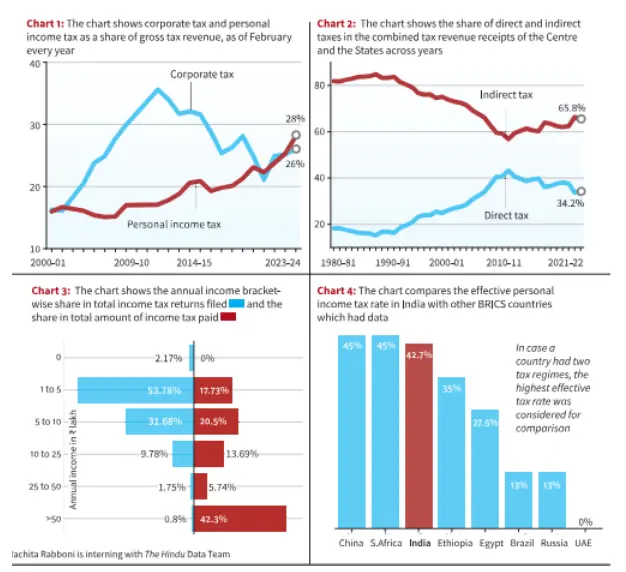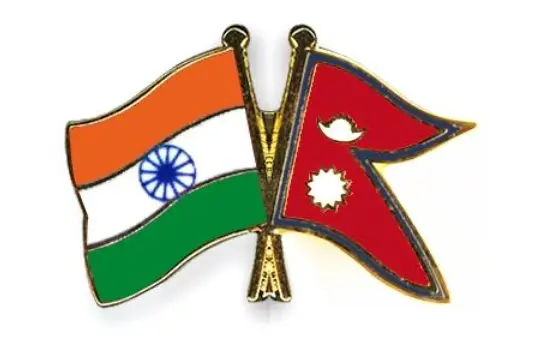Thursday, 9th May 2024
Artificial General Intelligence
In News: In a recent interview, the CEO of OpenAI reaffirmed the organization's commitment to investing in the progress of Artificial General Intelligence (AGI).
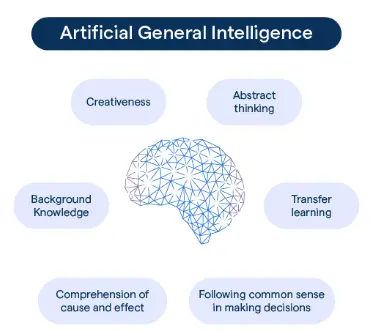
Understanding Artificial General Intelligence (AGI)
About
- AGI represents a highly advanced form of intelligence surpassing conventional Artificial Intelligence (AI).
- It envisions intelligence that transcends specific tasks, aiming for a broader, generalized form of intelligence.
- The goal is to create machines capable of human-like intelligence across various tasks, including reasoning, abstract thinking, and learning from new experiences.
Characteristics
- Generalization
- AGI can apply knowledge and skills across different tasks and domains, leveraging learning from one context to solve new problems.
- Complex Reasoning
- AGI engages in intricate reasoning and problem-solving activities.
- Learning
- It exhibits robust learning capabilities, acquiring knowledge and skills from data, experience, or instruction.
- Self-Awareness and Consciousness
- AGI possesses awareness of its existence and the ability to set goals.
- Human-Level Abilities
- AGI's capabilities match or exceed human intelligence.
- Creativity
- AGI demonstrates creativity by generating novel solutions or ideas not explicitly programmed.
Applications of AGI
- Healthcare
- AGI enhances personalized medicine through advanced analysis of diverse datasets.
- Finance and Business
- AGI automates tasks, improves decision-making, and provides real-time market analysis.
- Education Sector
- It revolutionizes adaptive learning platforms, offering personalized education globally.
- Space Exploration
- AGI operates autonomous systems and analyzes data for space exploration.
- Military and Defense
- AGI enhances surveillance, strategies, and combat systems.
Concerns Related to AGI
- Environmental Impact
- Development of AGI systems raises concerns about energy consumption and e-waste generation.
- Job Losses
- AGI may lead to significant job displacement and economic inequality.
- Human Oversight
- AGI's cognitive abilities could influence important areas like elections, raising concerns about accountability.
- Loss of Human Skills
- Reduced human involvement may diminish creativity and innovation.
- Existential Risk
- AGI's capabilities could surpass human control, posing existential risks.
- Ethical Dilemmas
- Advancement of AGI raises ethical concerns about responsibility and biased decision-making.
Way Forward
- Robust Ethical Frameworks
- Establish and enforce ethical guidelines for responsible AGI advancement and usage.
- Transparency and Accountability
- Prioritize transparency and explainability in AGI systems to ensure understandable decision-making processes.
- Ongoing Monitoring and Oversight
- Implement mechanisms for continuous monitoring and oversight to identify and address potential risks associated with AGI.
|
UPSC Previous Year Questions Prelims (2020) Q. With the present state of development, Artificial Intelligence can effectively do which of the following?
Select the correct answer using the code given below: (a) 1, 2, 3 and 5 only Ans: (b) Mains (2022) Q. What are the main socio-economic implications arising out of the development of IT industries in major cities of India? Mains (2020) Q. “The emergence of the Fourth Industrial Revolution (Digital Revolution) has initiated e-Governance as an integral part of government”. Discuss. |
Source: IE
The Kotak Mahindra Bank Controversy
In News: The Reserve Bank of India (RBI) has prohibited Kotak Mahindra Bank (KMB) from accepting new customers via its online and mobile banking platforms, as well as from issuing new credit cards.

Necessity of Actions on KMB as Per RBI Observations
Reasons for Necessitating Actions
- Identified Deficiencies by RBI
- RBI observed serious deficiencies and non-compliances in KMB's IT inventory, user access management, data leak prevention strategy, business continuity, and disaster recovery rigour.
- These observations were made over a two-year examination period (2022 and 2023).
- Lack of Timely Remediation
- KMB continually failed to address concerns comprehensively and in a timely manner.
- Non-compliance with RBI's Corrective Action Plans (CAPs) further exacerbated the situation.
- Importance of CAPs
- CAPs are integral to RBI's intervention scheme aimed at ensuring the robustness of regulated entities.
- However, KMB's compliance submissions were deemed inadequate, incorrect, or unsubstantiated by the regulator.
Past Instances of Similar Actions by RBI
- HDFC Cease on Digital Products
- In December 2020, RBI barred HDFC from launching new digital products and sourcing credit card consumers due to recurrent outages in its digital banking platforms.
- Restrictions were lifted in March 2022 after successful remediation.
- Bank of Baroda's Suspension
- In October 2023, RBI directed Bank of Baroda to suspend onboarding new customers onto its 'bob World' mobile application due to observed supervisory concerns.
Impact of RBI's Actions on KMB
- Effect on Growth Trajectory
- KMB's growth in retail products, facilitated by digital sourcing and emphasis on unsecured products, may be hindered.
- Significant reliance on digital means for personal loans and credit cards sales.
- Financial Implications
- S&P Global Ratings suggest the regulatory action could impede credit growth and profitability.
- Credit cards represent a lucrative growth segment, with a portfolio growth of 52% YoY.
- Operational Adjustments
- Potential shift towards physical branch network expansion to supplement growth, leading to higher operating costs.
- Reputational Concerns
- CEO expresses concerns about potential reputational impact.
- Timeline for Resolution
- Anticipated duration of about a year to fully address RBI's concerns.
- Technological enhancements and implementation changes, along with the external audit, will require time.
Source: TH
Draft Explosives Bill 2024
In News: The Government of India intends to substitute the Explosives Act of 1884 with the proposed Explosives Bill of 2024.
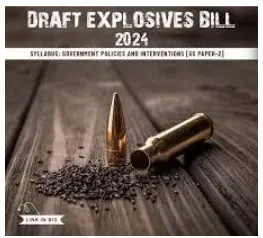
The Explosives Act of 1884 is a crucial piece of Indian legislation that governs the manufacture, possession, use, sale, transportation, import, and export of explosives in India. Here are the key points about the Act:
Historical Context
- Enacted during British colonial rule, the Explosives Act of 1884 aimed to regulate various aspects of explosives.
Safety Regulations
- The Act applies to various types of explosives, including gunpowder, dynamite, nitroglycerin, and other similar substances.
- The Act mandated safety standards and procedures to mitigate risks associated with explosives, encompassing handling, transportation, and storage guidelines to prevent accidents.
- The Act empowers the Central Government to make rules regulating the manufacture, possession, use, sale, transport, import, and export of explosives.
- These rules govern the issuance of licences, fees, conditions, and exemptions.
Prohibition of Dangerous Explosives
- The Central Government can prohibit the manufacture, possession, or importation of especially dangerous explosives in the interest of public safety.
Exemption
- The Act does not affect the provisions of the Arms Act, 1959.
- Provisions are made for licences issued under the Explosives Act to have the effect of licences under the Arms Act.
- The Arms Act of 1959 regulates the possession, acquisition, and carrying of ammunition and firearms. It also aims to curb illegal weapons and violence.
- The Arms Act of 1959 replaced the Indian Arms Act of 1878.
Evolution and Amendments
- Over time, the Explosives Act underwent several amendments to adapt to technological advancements and emerging challenges, primarily focusing on enhancing safety standards and regulatory mechanisms.
Source: BS
Central Bank Digital Currency (CBDC)
In News: GS – 2 Government Policies & Interventions GS – 3 Growth & Development, IT & Computers
Central Bank Digital Currency (CBDC) Overview
- About
- CBDC is a digital form of legal tender issued by a central bank.
- Unlike private cryptocurrencies, CBDCs are backed by the central bank, ensuring stability and trust.
- Exchangeable one-to-one with fiat currency, CBDC functions similarly to fiat currency.
- Transacted using blockchain-backed wallets.
- Objectives
- Mitigate risks and reduce costs associated with physical currency handling, including soiled notes, transportation, insurance, and logistics.
- Deter the use of cryptocurrencies for money transfer.
- Global Trends
- Bahamas introduced Sand Dollar as the first nationwide CBDC in 2020.
- Nigeria rolled out eNaira in 2020.
- China piloted e-CNY in April 2020.
- Major Advantages of CBDC
- Enhanced Security
- Leveraging digital security measures to reduce counterfeiting and theft risks.
- Improved Efficiency
- Facilitating faster and more cost-effective digital transactions.
- Financial Inclusion
- Reaching unbanked and underbanked populations through secure digital payment options.
- Encouraging formalization of the informal economy for better tax and regulatory compliance.
- Enhanced Anonymity
- Exploring permanent transaction deletion to provide anonymity comparable to cash transactions.
- Offline Functionality
- Enabling offline transferability to overcome rural internet connectivity limitations.
- Programmability
- Introducing programmable features for targeted government benefit disbursement and financial behaviour encouragement.
- Cross-Border Transactions
- Revolutionizing cross-border transactions with instant settlement, making payments cheaper, faster, and more secure.
- Traditional and Innovative
- Gradually shifting towards virtual currency to reduce currency handling costs.
- Improved Monetary Policy
- Providing central banks with greater control over money supply and interest rates for more effective interventions.
- Enhanced Security
- Challenges Associated with CBDC
- Cybersecurity Concerns
- Crucial need for robust security measures to protect against cyberattacks.
- Privacy Issues
- Balancing user privacy with anti-money laundering and terrorism financing measures.
- UPI Preference and Interoperability
- Continued retail user preference for UPI despite efforts to promote CBDC.
- Non-Remunerative CBDC
- Making CBDC non-interest-bearing to mitigate bank disintermediation risks.
- Competition with Private Banks
- Potential competition with private banks for deposits, impacting lending and investment.
- Monetary Policy
- Unclear impact of CBDCs on monetary policy tools like interest rates.
- Conclusion
- RBI's commitment to addressing privacy concerns reflects dedication to successful CBDC implementation.
- Emphasis on anonymity, accessibility, and functionality indicates India's progressive stance in the evolving digital currency landscape.
- Cybersecurity Concerns
|
UPSC Previous Year Questions Prelims (2023) Q. With reference to Central Bank digital currencies, consider the following statements:
Which of the statements given above is/are correct? (a) 1 only Ans: (c) |
Source: IE
Central Drugs Standard Control Organisation (CDSCO)
In News: Amid heightened global scrutiny of drugs manufactured in India, the Central Drugs Standard Control Organisation (CDSCO) has assumed exclusive authority for issuing manufacturing licenses for new drugs intended for export.
Overview of the Central Drugs Standard Control Organisation (CDSCO)
- The Central Drugs Standard Control Organisation (CDSCO) functions as the National Regulatory Authority (NRA) in India for the medical devices industry, operating under the provisions of the Drugs and Cosmetics Act.
- Its primary responsibility encompasses overseeing the import, manufacture, sale, and distribution of medical devices within the country, ensuring compliance with safety, quality, and efficacy standards.
- The CDSCO operates under the Directorate General of Health Services, which falls under the Ministry of Health & Family Welfare of the Government of India.
- At the helm of the CDSCO is the Drugs Controller General of India (DCGI), who oversees its operations and regulatory functions.
- Headquartered in New Delhi, the CDSCO holds various responsibilities under the Drugs and Cosmetics Act:
- Approval of new drugs
- Conducting clinical trials
- Establishing standards for drugs
- Monitoring the quality of imported drugs
- Coordinating with State Drug Control Organizations
- Together with state regulators, the CDSCO shares the responsibility for granting licenses for specialized categories of critical drugs, including blood and blood products, I.V. fluids, vaccines, and sera.
- The CDSCO carries out inspections and audits to ensure that medical device companies adhere to regulations regarding safety, quality, and efficacy.
Source: LM
Shinkun La Tunnel
In News: The Border Roads Organisation (BRO) is gearing up to initiate the construction of the Shinkun La Tunnel.
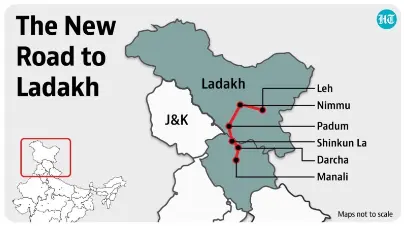
Overview of Shinkun La Tunnel and Border Roads Organisation (BRO)
- The Shinkun La Tunnel is an upcoming motorable passage situated beneath the 16,580 feet high Shinku-La pass, linking Himachal’s Lahaul valley and Ladakh’s Zanskar valley.
- Positioned on the Nimu-Padam-Darcha Road link, the tunnel spans a length of 4.1 kilometers.
- Upon completion, it will emerge as the longest high altitude highway tunnel worldwide.
- The Border Roads Organization (BRO) has undertaken the construction of the tunnel at an estimated cost of Rs. 1,681.5 crores.
- Once operational, the Shinku-la tunnel will furnish all-weather road connectivity to Ladakh, serving as the shortest route to Ladakh's border areas.
- Its construction is anticipated to facilitate the transportation of heavy machinery to strategic locations like Kargil, Siachen, and the Line of Control (LOC), effectively shortening travel distances by approximately 100 kilometers.
- Notably, traffic movement within the tunnel will be immune to long-range artillery shelling or missile firings from adversaries like China or Pakistan.
Border Roads Organisation (BRO)
- The Border Roads Organisation (BRO) is a dedicated road construction executive force in India, offering support to the Indian Armed Forces.
- Established on May 7, 1960, its primary objectives include securing India's borders and developing infrastructure in remote regions of the northern and northeastern states.
- The BRO undertakes the development and maintenance of road networks in India's border areas as well as in friendly neighboring countries.
- Its operational scope spans across 19 states, three union territories, and neighboring countries such as Afghanistan, Bhutan, Myanmar, Tajikistan, and Sri Lanka.
- Personnel from the General Reserve Engineer Force (GREF) constitute the parent cadre of the BRO, complemented by officers and troops from the Indian Army's Corps of Engineers on deputation.
- The BRO is incorporated into the Order of Battle of the Armed Forces, ensuring its availability for support whenever required.
- The organization's motto, "Shramena Sarvam Sadhyam" translates to "everything is achievable through hard work."
Source: HT
Glyptothorax punyabratai
In News: The newly discovered catfish species, Glyptothorax punyabratai, was recently identified by the ICAR-NBFGR in the untouched waters of Arunachal Pradesh, India.

Introduction to Glyptothorax punyabratai and Key Facts about Catfish
Glyptothorax punyabratai
- Glyptothorax punyabratai is a newly discovered catfish species.
- It was discovered in the Tung Stream, a tributary of the Tissa River, situated within the Brahmaputra River basin.
Key Facts about Catfish
- Catfish comprise one of the largest groups of freshwater fishes, boasting a diversity of over 2000 species.
- While the majority of catfish species inhabit freshwater environments, a select few are found in marine habitats.
- Most catfish are nocturnal, displaying activity primarily during the night.
- Catfish are predominantly benthic, meaning they dwell near or at the bottom of water bodies.
- Physically, catfish typically feature a cylindrical body with a flattened ventral area, facilitating their benthic feeding habits.
- They derive their name from the long barbels, or feelers, located around their mouths, resembling the whiskers of cats.
- Many catfish species possess prominent spines in their dorsal and pectoral fins.
- A distinctive characteristic of catfish is their lack of scales, setting them apart from other fish species.
Source: KC
West Nile Fever
In News: The health department of Kerala has recently announced cases of West Nile Fever in three districts.
Overview of West Nile Fever
- West Nile Fever is a disease caused by the West Nile Virus (WNV), which is a member of the flavivirus genus and belongs to the Japanese encephalitis antigenic complex of the family Flaviviridae.
- Birds serve as the natural hosts of WNV, and the virus is commonly found in Africa, Europe, the Middle East, North America, and West Asia.
- Transmission primarily occurs through the bite of an infected mosquito, which acquires the virus by biting an infected bird. While there's no direct evidence of person-to-person transmission, rare cases have been documented through organ transplants.
- Symptoms of West Nile Fever vary, with many infected individuals being asymptomatic. Common symptoms include fever, headache, tiredness, body aches, nausea, vomiting, occasional skin rash, and swollen lymph glands.
- Severe cases, known as neuroinvasive disease, can manifest with symptoms such as high fever, neck stiffness, stupor, disorientation, coma, tremors, convulsions, muscle weakness, and paralysis.
- Currently, there is no specific medicine or vaccine available to treat or prevent WNV infection. Treatment primarily focuses on supportive care, including hospitalization, intravenous fluids, respiratory support, and prevention of secondary infections.
Source: LM
Pyrenees Mountains
In News: The President of France recently welcomed President Xi Jinping of China to the Tourmalet Pass in the Pyrenees for confidential discussions.
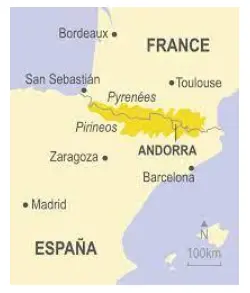
Overview of the Pyrenees Mountains
- The Pyrenees Mountains form a natural boundary between Spain and France in southwestern Europe, characterized by a chain of mountains.
- These mountains are the result of fold mountain formation, caused by the collision of the microcontinent of Iberia with the larger Eurasian plate.
- In comparison to the Alps, the Pyrenees are relatively older mountains.
- Stretching approximately 500 km from the Mediterranean Sea's coastline in the east to the Bay of Biscay in the west, the Pyrenees encompass a significant geographic span.
- At its easternmost point, the Pyrenees measure six miles in width, expanding to 80 miles in the central region.
- Politically, the Pyrenees are divided into the Spanish and French regions, with the small nation of Andorra nestled between them in the eastern section of the mountain range.
- Geographically, the Pyrenees separate continental Europe from the Iberian Peninsula.
- The western terminus of the Pyrenees Mountains merges with the Cantabrian Mountains, situated in the northern part of the Iberian Peninsula.
- Aneto Peak, located in Spain, stands as the highest summit in the Pyrenees Mountains, reaching an elevation of 3,404 meters.
Source: OI
Getting to a new level in India’s online gaming sector
In News: A recent article discusses the emergence of India's gaming industry and the obstacles it faces.
Factors Contributing to the Rise of India's Gaming Industry
- Enhanced Internet Infrastructure and Connectivity
- The expansion of broadband connectivity to Tier-II and Tier-III cities has broadened the reach of online gaming.
- Initiatives like BharatNet and the National Broadband Mission aim to provide high-speed internet access to rural areas.
- The proliferation of 4G and the rollout of 5G networks have improved internet speeds, crucial for seamless online gaming experiences.
- Affordable Access to Data and Smartphones
- Decreasing costs of mobile data plans have made data more accessible and affordable for online gaming.
- This accessibility has democratized technology, leading to increased online gaming adoption across socio-economic groups.
- India's substantial smartphone base, with over 80% being 4G smartphones, has significantly contributed to the gaming market.
- Cultural Shift and Changing Perceptions
- The Covid-19 lockdown accelerated the adoption of online gaming as a form of virtual entertainment and social connection.
- Indians' average time spent on online games increased during the lockdown, leading to a shift in perception, viewing online gaming as a viable career option.
- Government Support and Regulatory Clarity
- Initiatives like the IT Rules 2021 provide a regulatory framework for online gaming, addressing concerns about harmful content and addiction.
- The government's decision to allow 100% Foreign Direct Investment (FDI) in the gaming sector and recognition of gamers in awards enhance the sector's growth.
- Rise of E-sports and Competitive Gaming
- Inclusion of e-sports in prestigious events like the Commonwealth Games 2022 has elevated its status and recognition.
- Success of Indian teams and players on global esports platforms has boosted the industry's profile.
- Integration of Cutting-Edge Technologies
- Incorporation of technologies like Augmented Reality (AR), Virtual Reality (VR), cloud gaming, and blockchain has enhanced the gaming experience and fostered innovation.
- Thriving Start-up Ecosystem and Investment Inflow
- India's vibrant start-up ecosystem has given rise to numerous gaming companies, driving innovation and catering to diverse gaming preferences.
- India boasts gaming unicorns like Game 24X7, Dream11, and Mobile Premier League.
Major Challenges Related to India's Gaming Sector
- Regulatory Ambiguity and Fragmented Policies
- Lack of a comprehensive regulatory framework has created ambiguity and uncertainty.
- Different states have different laws, leading to a fragmented policy landscape.
- Taxation Concerns and Sustainability Challenges
- Imposition of a 28% GST on bets raises concerns about long-term sustainability, particularly for smaller startups.
- Critics argue high tax rates could stifle innovation and hamper growth.
- Infrastructure and Connectivity Challenges
- Reliable and high-speed internet connectivity remains a challenge, especially in rural areas.
- Disparity exists between rural and urban internet usage.
- Content Localization and Cultural Relevance
- Developing games that resonate with India's diverse cultural and linguistic landscapes can be challenging.
- While some games succeed, many international games struggle to connect with Indian audiences.
- Responsible Gaming and Addiction Concerns
- Concerns about gaming addiction, especially among younger populations, are growing.
- Prevalence of internet gaming disorder is a significant concern.
Measures to Enhance the Gaming Industry in India
- Regulatory Clarity
- Enhance regulatory clarity, especially regarding the effective implementation of self-regulatory bodies mandated by the IT Rules of 2021.
- Dedicated Gaming Hubs and Incubators
- Establish specialized gaming hubs and incubators to foster innovation, collaboration, and talent development.
- Promotion of Game Development based on Indian Culture and Mythology
- Incentivize developers to create games based on India's rich cultural heritage, mythology, and folklore.
- Innovative Funding and Investment Models
- Encourage alternative funding models like crowdfunding and venture capital investments to support game development.
- Empowerment of Women in Gaming
- Promote and support women in the gaming industry to unlock talent and diverse perspectives.
- Promote Cross-Industry Collaborations
- Foster collaborations between the gaming industry and other sectors to explore the potential of gamification and serious games.
|
UPSC Previous Year Questions Prelims (2018) Q. Which of the following is/are the aim/aims of “Digital India” Plan of the Government of India?
Select the correct answer using the code given below: (a) 1 and 2 only (b) 3 only (c) 2 and 3 only (d) 1, 2 and 3 Ans: (b) |
Source: TH
Share the article
Edukemy’s Current Affairs Quiz is published with multiple choice questions for UPSC exams
MCQ
Get Latest Updates on Offers, Event dates, and free Mentorship sessions.

Get in touch with our Expert Academic Counsellors 👋
Frequently Asked Questions
UPSC Daily Current Affairs focuses on learning current events on a daily basis. An aspirant needs to study regular and updated information about current events, news, and relevant topics that are important for UPSC aspirants. It covers national and international affairs, government policies, socio-economic issues, science and technology advancements, and more.
UPSC Daily Current Affairs provides aspirants with a concise and comprehensive overview of the latest happenings and developments across various fields. It helps aspirants stay updated with current affairs and provides them with valuable insights and analysis, which are essential for answering questions in the UPSC examinations. It enhances their knowledge, analytical skills, and ability to connect current affairs with the UPSC syllabus.
UPSC Daily Current Affairs covers a wide range of topics, including politics, economics, science and technology, environment, social issues, governance, international relations, and more. It offers news summaries, in-depth analyses, editorials, opinion pieces, and relevant study materials. It also provides practice questions and quizzes to help aspirants test their understanding of current affairs.
Edukemy's UPSC Daily Current Affairs can be accessed through:
- UPSC Daily Current Affairs can be accessed through Current Affairs tab at the top of the Main Page of Edukemy.
- Edukemy Mobile app: The Daily Current Affairs can also be access through Edukemy Mobile App.
- Social media: Follow Edukemy’s official social media accounts or pages that provide UPSC Daily Current Affairs updates, including Facebook, Twitter, or Telegram channels.


